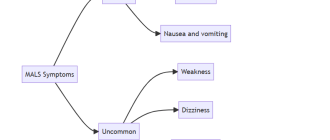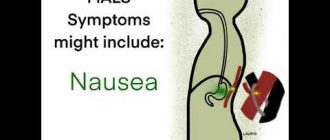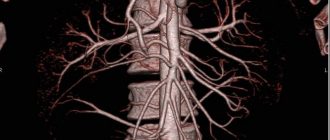 Recognizing the Signs and Symptoms of Mesenteric Thrombosis: What You Need to Know
Recognizing the Signs and Symptoms of Mesenteric Thrombosis: What You Need to Know
Mesenteric thrombosis is a rare but serious medical condition that occurs when a blood clot forms in one of the arteries that supply blood to the intestines. This can lead to a blockage in the blood flow, causing tissue damage and potentially life-threatening complications. Recognizing the symptoms of mesenteric thrombosis is crucial for early diagnosis and treatment.
One of the most common symptoms of mesenteric thrombosis is severe abdominal pain. The pain may start suddenly and be constant or intermittent. It is often described as cramping or colicky, and may worsen after eating. The affected area may also feel tender to the touch. In some cases, the pain may be accompanied by nausea, vomiting, and diarrhea.
Other symptoms of mesenteric thrombosis may include bloody stools, fever, and rapid heartbeat. The presence of these symptoms may indicate that the blood clot has caused tissue damage and inflammation in the intestines. If left untreated, mesenteric thrombosis can lead to bowel infarction, which is a life-threatening condition where a section of the intestine dies due to lack of blood supply.
It is important to note that the symptoms of mesenteric thrombosis may vary depending on the location and extent of the blood clot. Some individuals may experience milder symptoms, while others may have more severe manifestations. If you experience any of the symptoms mentioned above, it is important to seek medical attention immediately to prevent further complications.
Mesenteric thrombosis is a serious condition that can lead to tissue damage and life-threatening complications. Recognizing the symptoms, such as severe abdominal pain, bloody stools, and fever, is crucial for early diagnosis and treatment. If you suspect that you or someone you know may have mesenteric thrombosis, do not hesitate to seek medical attention.
What are the symptoms of a blocked mesenteric artery?
When the mesenteric artery becomes blocked, it can lead to a condition called mesenteric thrombosis. This occurs when a blood clot forms in the artery, preventing blood flow to the intestines. The symptoms of a blocked mesenteric artery can be severe and require immediate medical attention.
Some common symptoms of a blocked mesenteric artery include:
- Severe abdominal pain that comes on suddenly
- Nausea and vomiting
- Loss of appetite
- Bloody or dark stools
- Diarrhea
- Bloating or distention of the abdomen
- Fever
- Rapid heart rate
The abdominal pain associated with a blocked mesenteric artery is often described as a “colicky” pain, meaning it comes and goes in waves. The pain may be located in the middle or lower abdomen and can be intense.
If you experience any of these symptoms, it is important to seek immediate medical attention. Mesenteric thrombosis is a serious condition that can lead to tissue death in the intestines if left untreated. Prompt diagnosis and treatment are crucial for a successful outcome.
Overview of symptoms
Mesenteric thrombosis occurs when a blood clot forms in one of the major blood vessels that supplies blood to the intestines. This can lead to a range of symptoms, which can vary depending on the extent of the clot and the affected area. The symptoms of mesenteric thrombosis can include:
| Symptoms | Description |
|---|---|
| Severe abdominal pain | One of the most common symptoms of mesenteric thrombosis is severe abdominal pain. The pain may be constant or intermittent and is often described as crampy or colicky. |
| Nausea and vomiting | Many individuals with mesenteric thrombosis experience nausea and vomiting, which can be a result of the severe abdominal pain or due to the disruption of blood flow to the intestines. |
| Bloody stools | In some cases, mesenteric thrombosis can cause bloody stools. This occurs when the blood clot blocks the blood supply to a portion of the intestine, leading to tissue damage and bleeding. |
| Diarrhea | Diarrhea may occur as a result of the reduced blood flow to the intestines. The stool may be loose, watery, or contain mucus. |
| Fever | In cases where there is extensive tissue damage or infection, a fever may develop. This can be a sign of a serious complication and requires immediate medical attention. |
| Weight loss | Unexplained weight loss may occur in individuals with mesenteric thrombosis, especially if the condition leads to chronic malabsorption or reduced appetite. |
It is important to note that these symptoms can also be associated with other gastrointestinal conditions, so a thorough medical evaluation is necessary to determine the underlying cause.
Explanation of how blockage leads to these symptoms
When a blockage occurs in the mesenteric arteries, it restricts or completely cuts off the blood supply to the intestines. This lack of blood flow leads to various symptoms that can be severe and life-threatening.
One of the main symptoms of mesenteric thrombosis is severe abdominal pain. The blockage causes ischemia, which is the insufficient supply of oxygen to the intestines. This leads to tissue damage and the release of chemicals that trigger pain signals. The pain is usually constant and can be described as cramping or colicky.
Another common symptom is nausea and vomiting. The lack of blood flow and oxygen to the intestines can cause the digestive system to become disrupted. This can result in feelings of nausea and a reflexive response of vomiting. The vomit may contain bile or blood if the blockage is severe.
Bloody stools are also a symptom of mesenteric thrombosis. The reduced blood flow to the intestines can cause ulcers or even necrosis, which is the death of tissue. This can result in bleeding, which can be seen in the stool. The stool may appear dark and tarry or contain bright red blood.
In severe cases, mesenteric thrombosis can lead to bowel ischemia or infarction. This occurs when the blockage is so severe that a portion of the intestine dies due to lack of blood flow. Symptoms of bowel ischemia or infarction include severe abdominal pain, fever, and bloody stools. This is a medical emergency and requires immediate intervention.
The blockage of mesenteric arteries leads to symptoms such as severe abdominal pain, nausea and vomiting, bloody stools, and in severe cases, bowel ischemia or infarction. These symptoms arise due to the lack of blood flow and oxygen to the intestines, resulting in tissue damage and dysfunction of the digestive system.
What are the symptoms of mesenteric thrombosis?
Mesenteric thrombosis occurs when a blood clot forms in one of the arteries that supply blood to the intestines. This condition can be life-threatening and requires immediate medical attention. The symptoms of mesenteric thrombosis can vary depending on the severity of the clot and the extent of the blockage. Common symptoms include:
- Severe abdominal pain: One of the main symptoms of mesenteric thrombosis is intense abdominal pain, typically located in the middle or lower abdomen. The pain may be constant or come and go, and it may worsen after eating.
- Nausea and vomiting: Mesenteric thrombosis can cause nausea and vomiting, which may be accompanied by a loss of appetite.
- Bloody stools: In some cases, mesenteric thrombosis can result in bloody stools or rectal bleeding. This is a serious symptom that should not be ignored.
- Diarrhea: Another common symptom of mesenteric thrombosis is diarrhea, which may be watery or bloody.
- Weight loss: Unexplained weight loss can occur in individuals with mesenteric thrombosis, as the condition can interfere with the absorption of nutrients from food.
- Fever: In certain cases, mesenteric thrombosis can cause a fever, which may be accompanied by chills and sweating.
If you experience any of these symptoms, especially severe abdominal pain, it is important to seek immediate medical attention. Mesenteric thrombosis is a serious condition that requires prompt diagnosis and treatment to prevent further complications.
List of common signs and symptoms
- Severe abdominal pain
- Nausea and vomiting
- Bloody stools
- Diarrhea
- Fever
- Unexplained weight loss
- Loss of appetite
- Abdominal distension
- Fatigue
- Jaundice
- Changes in bowel movements
If you experience any of these symptoms, it is important to seek medical attention immediately, as mesenteric thrombosis can be a life-threatening condition.
Description of clinical presentation
Mesenteric thrombosis refers to the formation of a blood clot in the mesenteric vessels, which supply blood to the intestines. This condition can cause a variety of symptoms, which can vary depending on the severity and location of the clot.
One of the most common symptoms of mesenteric thrombosis is severe abdominal pain. This pain is often described as sudden and intense, and it typically occurs in the middle or lower abdomen. The pain may be constant or intermittent, and it may worsen after eating.
Other symptoms of mesenteric thrombosis can include nausea, vomiting, and diarrhea. These gastrointestinal symptoms can be caused by reduced blood flow to the intestines, leading to inflammation and damage. In severe cases, these symptoms may progress to bloody stools or signs of bowel obstruction.
In some cases, mesenteric thrombosis can also cause systemic symptoms such as fever, fatigue, and weight loss. These symptoms may be the result of the body’s response to the clot and the resulting inflammation.
If left untreated, mesenteric thrombosis can lead to serious complications such as bowel infarction (tissue death), peritonitis (inflammation of the abdominal lining), and sepsis (a life-threatening infection). Therefore, it is important to seek medical attention if you experience any of the symptoms associated with mesenteric thrombosis.
It is important to note that the symptoms of mesenteric thrombosis can be similar to those of other abdominal conditions, so a thorough medical evaluation is necessary for an accurate diagnosis.
What are the symptoms of a thrombosis in the stomach?
A thrombosis in the stomach, also known as mesenteric thrombosis, occurs when a blood clot forms in the blood vessels that supply the intestines. This condition can be life-threatening and requires immediate medical attention. The symptoms of a thrombosis in the stomach can vary depending on the severity and location of the clot, but common symptoms include:
1. Abdominal pain: Severe, crampy abdominal pain is a hallmark symptom of mesenteric thrombosis. The pain may be constant or intermittent and can worsen after eating. It is often described as a sharp, stabbing pain that is localized to the area of the clot.
2. Nausea and vomiting: Many individuals with a thrombosis in the stomach experience nausea and vomiting. This can be due to the interruption of blood flow to the intestines, which can lead to inflammation and irritation.
3. Diarrhea: Mesenteric thrombosis can cause diarrhea, which may be bloody in some cases. The blood in the stool can be a sign of damage to the intestines caused by the lack of blood flow.
4. Abdominal distension: As the thrombosis progresses, it can lead to abdominal distension or bloating. This occurs as a result of impaired blood flow and the accumulation of fluid and gas in the intestines.
5. Fever: In some cases, a thrombosis in the stomach can cause a low-grade fever. This can be a sign of infection or inflammation in the intestines.
6. Rapid heart rate: An increased heart rate, known as tachycardia, can occur due to the body’s response to the clot and decreased blood flow to the intestines.
If you experience any of these symptoms, it is important to seek immediate medical attention. Mesenteric thrombosis is a serious condition that requires prompt diagnosis and treatment to prevent complications and improve outcomes.
Details on gastric thrombosis symptoms
Gastric thrombosis is a condition characterized by the formation of blood clots in the blood vessels of the stomach. It can lead to serious complications if left untreated. Recognizing the symptoms of gastric thrombosis is crucial for early diagnosis and prompt medical intervention.
Some of the common symptoms of gastric thrombosis include:
- Abdominal pain: A persistent, severe abdominal pain is often the first symptom of gastric thrombosis. The pain may be localized and can worsen after eating or drinking.
- Nausea and vomiting: Gastric thrombosis can cause nausea and vomiting, which may be accompanied by blood or coffee ground-like material.
- Loss of appetite: Individuals with gastric thrombosis may experience a loss of appetite and have difficulty eating.
- Bloody stools: In some cases, gastric thrombosis can cause blood in the stool, which may appear bright red or black and tarry.
- Unexplained weight loss: The formation of blood clots in the stomach can interfere with the absorption of nutrients, leading to unexplained weight loss.
- Feeling of fullness: Gastric thrombosis can cause a feeling of fullness or discomfort in the stomach, even after consuming small amounts of food.
If you experience any of these symptoms or suspect gastric thrombosis, it is important to seek medical attention immediately. Prompt diagnosis and treatment can help prevent complications and improve outcomes.
How presentation differs from intestinal thrombosis
Mesenteric thrombosis and intestinal thrombosis are two different conditions that affect the blood vessels in the abdomen. While they may have similar symptoms, there are some key differences in their presentation.
In mesenteric thrombosis, the blood clot forms in one of the mesenteric arteries, which supply blood to the intestines. This can lead to a sudden and severe abdominal pain, which may be accompanied by nausea, vomiting, and diarrhea. The pain is typically constant and does not improve with bowel movements. In some cases, there may be blood in the stool or signs of intestinal ischemia.
On the other hand, intestinal thrombosis refers to the formation of a blood clot within one of the veins that drain blood from the intestines. This condition is often associated with underlying medical conditions, such as inflammatory bowel disease or cancer. The symptoms of intestinal thrombosis can vary depending on the location and extent of the clot. They may include abdominal pain, bloating, diarrhea, and blood in the stool. Unlike mesenteric thrombosis, the pain in intestinal thrombosis may come and go and is often relieved by bowel movements.
While both mesenteric thrombosis and intestinal thrombosis involve blood clots in the abdomen, their presentations differ in terms of the location of the clot, the severity and duration of the abdominal pain, and associated symptoms. It is important to seek medical attention promptly if you experience any symptoms of these conditions, as they can be serious and require immediate treatment.
How does pain present in mesenteric thrombosis?
Pain is the most common symptom of mesenteric thrombosis and is typically severe and sudden in onset. The pain is often described as crampy or colicky, and it is usually located in the abdominal area. Patients may also experience bloating, distension, and a feeling of fullness.
The location of the pain can depend on which artery is affected by the thrombosis. If the superior mesenteric artery is involved, the pain is typically located in the middle or upper abdomen. In cases where the inferior mesenteric artery is affected, the pain may be felt in the lower abdomen.
In addition to the location, the timing of the pain can also vary. Some patients may experience continuous pain, while others may have intermittent episodes of pain. The pain may worsen after eating and may be relieved by bowel movements or vomiting.
It is important to note that the pain in mesenteric thrombosis can be severe and persistent, and it is often accompanied by other symptoms such as nausea, vomiting, diarrhea, and fever. If you experience these symptoms, it is important to seek medical attention as mesenteric thrombosis is a serious condition that requires immediate treatment.
| Common Symptoms of Mesenteric Thrombosis |
|---|
| Pain in the abdomen |
| Bloating and distension |
| Feeling of fullness |
| Nausea and vomiting |
| Diarrhea |
| Fever |
If you suspect you may have mesenteric thrombosis, it is important to seek medical attention immediately. Early diagnosis and treatment can help prevent complications and improve outcomes.
Characterization of the pain pattern
The pain experienced by individuals with mesenteric thrombosis can vary in intensity and location. It is typically characterized as severe and persistent, often described as a constant, cramping pain. The pain may be localized to the abdomen, but it can also radiate to the back or other areas of the body.
Patients may also experience a bloated or distended feeling in the abdomen, along with nausea and vomiting. These symptoms can be indicative of bowel obstruction, which can occur as a result of the thrombus blocking blood flow to the intestines.
In some cases, the pain may worsen after eating, particularly after consuming fatty or greasy foods. This is because the presence of food in the digestive system can put additional strain on the already compromised blood flow.
It is important to note that the pain associated with mesenteric thrombosis can mimic other conditions, such as appendicitis or pancreatitis. Therefore, a thorough medical evaluation is necessary to accurately diagnose and treat the underlying cause of the symptoms.
Analysis of pain location, severity, duration
Understanding the location, severity, and duration of pain can provide valuable insights into the diagnosis of mesenteric thrombosis.
Pain in mesenteric thrombosis typically starts suddenly and is often severe. The location of the pain can vary depending on the affected area of the mesentery, which is the tissue that connects the intestines to the abdominal wall.
Common locations of pain include the lower abdomen, around the belly button, or in the upper abdomen. The pain may be constant or intermittent, and it may worsen after eating or with movement.
Severity of pain can range from moderate to severe, with some individuals experiencing excruciating pain. The intensity of pain can help healthcare providers assess the severity of the thrombosis and its potential complications.
The duration of pain can also provide important diagnostic information. In mesenteric thrombosis, the pain is usually persistent and does not subside with simple measures such as rest or over-the-counter pain medications. If the pain persists for a prolonged period, it may indicate a more serious condition requiring immediate medical attention.
It is important to note that pain alone may not be sufficient for diagnosing mesenteric thrombosis, as other conditions can cause similar symptoms. Therefore, a thorough medical evaluation including imaging tests, blood tests, and a review of medical history is necessary for an accurate diagnosis.
| Pain Location | Pain Severity | Pain Duration |
|---|---|---|
| Lower abdomen | Moderate to severe | Persistent |
| Around the belly button | Varies | Persistent |
| Upper abdomen | Severe | Persistent |
What are warning signs that suggest mesenteric thrombosis?
Mesenteric thrombosis is a serious condition that occurs when a blood clot forms in one of the arteries that supply the intestines. It can cause severe abdominal pain and other symptoms. Recognizing the warning signs of mesenteric thrombosis is crucial for early diagnosis and treatment. Here are some common symptoms that may suggest mesenteric thrombosis:
- Severe abdominal pain that comes on suddenly
- Pain that is constant and does not go away
- Pain that gets worse after eating
- Nausea and vomiting
- Diarrhea or bloody stools
- Lack of appetite and weight loss
- Bloating and abdominal distension
- Fever and chills
- Weakness and fatigue
If you experience any of these symptoms, it is important to seek medical attention immediately. Mesenteric thrombosis can be a life-threatening condition if left untreated. A prompt diagnosis and treatment can help prevent complications and improve outcomes.
Overview of ‘red flag’ symptoms
Recognizing the early signs and symptoms of mesenteric thrombosis is crucial for prompt diagnosis and treatment. There are several ‘red flag’ symptoms that should not be ignored:
- Severe abdominal pain that starts suddenly and is constant
- Abdominal distension or bloating
- Nausea and vomiting
- Fever and chills
- Rapid heart rate
- Decreased bowel sounds
- Blood in the stool
- Unexplained weight loss
- Signs of dehydration
If you experience any of these symptoms, it is important to seek medical attention immediately, as mesenteric thrombosis can lead to serious complications if left untreated.
Explanation of their clinical significance
The symptoms of mesenteric thrombosis are of great clinical significance as they can help in the timely diagnosis and treatment of the condition. Early recognition of these symptoms is crucial in order to prevent complications and improve patient outcomes.
One of the most common symptoms of mesenteric thrombosis is severe abdominal pain, which is often described as a sharp, crampy pain. This pain is typically constant and may worsen with movement or eating. It is caused by the lack of blood flow to the intestines due to the clot formation, leading to tissue ischemia and necrosis.
Another important symptom is nausea and vomiting, which may be accompanied by diarrhea. These gastrointestinal symptoms can occur due to the disruption of normal gut function caused by the reduced blood supply to the intestines. Additionally, the clot itself can cause irritation and inflammation of the bowel, leading to these symptoms.
Patients with mesenteric thrombosis may also experience weight loss and a decreased appetite. The lack of blood flow to the intestines can impair the absorption of nutrients, leading to malnutrition and subsequent weight loss. Additionally, the abdominal pain and gastrointestinal symptoms can further contribute to a reduced appetite and weight loss.
In some cases, mesenteric thrombosis can lead to the development of systemic symptoms such as fever and fatigue. These symptoms may occur due to the body’s immune response to the clot and the resulting tissue damage. Fever can be a sign of inflammation, while fatigue may be a result of the systemic effects of the clot on the body.
Overall, the symptoms of mesenteric thrombosis should not be ignored and should prompt immediate medical attention. They can help in the diagnosis of the condition and guide appropriate treatment interventions, such as anticoagulation therapy or surgery, to restore blood flow to the intestines and prevent further complications.
Can mesenteric thrombosis be asymptomatic?
Mesenteric thrombosis is a condition that occurs when a blood clot forms in one of the arteries that supply blood to the intestines. This can lead to a blockage in the blood flow and cause severe complications if not treated promptly. While mesenteric thrombosis is typically associated with symptoms such as severe abdominal pain, nausea, vomiting, and diarrhea, there are cases where it can be asymptomatic.
Asymptomatic mesenteric thrombosis refers to a situation where a blood clot forms in the mesenteric arteries, but the individual does not experience any noticeable symptoms. This can make the diagnosis challenging, as the absence of symptoms may lead to a delay in seeking medical attention. However, it is important to note that even in cases of asymptomatic mesenteric thrombosis, the clot can still cause damage to the intestines and lead to serious complications if left untreated.
Some individuals may have underlying conditions or risk factors that increase their chances of developing asymptomatic mesenteric thrombosis. These risk factors may include a history of blood clotting disorders, atherosclerosis, certain medications, or surgery. Additionally, individuals who have previously experienced mesenteric thrombosis may be more prone to developing asymptomatic cases in the future.
Regular check-ups and monitoring of individuals with known risk factors for mesenteric thrombosis can help detect asymptomatic cases early on. Diagnostic tests such as ultrasound, CT scan, or angiography may be used to confirm the presence of a blood clot in the mesenteric arteries, even in the absence of symptoms.
While mesenteric thrombosis is typically associated with symptoms such as abdominal pain and digestive issues, it is possible for the condition to be asymptomatic. It is important for individuals with risk factors to undergo regular screenings and seek medical attention if they experience any concerning symptoms or changes in their health.
Discussion of asymptomatic presentations
Although mesenteric thrombosis typically presents with severe abdominal pain and other symptoms, there are some cases where patients may be asymptomatic. These asymptomatic presentations can be challenging to diagnose, as they may be discovered incidentally during imaging or surgical procedures.
One possible reason for an asymptomatic presentation is the development of collateral blood vessels. These vessels can form over time in response to the blockage of the mesenteric artery, allowing blood to bypass the clot and maintain blood flow to the intestines. As a result, patients may not experience symptoms until the collateral blood vessels become insufficient to provide adequate blood supply.
In some cases, patients with mesenteric thrombosis may have vague or mild symptoms that are easily overlooked or attributed to other causes. These symptoms can include indigestion, bloating, mild abdominal discomfort, or changes in bowel habits. As a result, the diagnosis of mesenteric thrombosis may be delayed, leading to potential complications.
It is important for healthcare providers to consider mesenteric thrombosis as a possible cause for these atypical presentations, especially in patients with risk factors such as a history of blood clotting disorders, recent surgery or trauma, or underlying vascular disease. Imaging studies, such as CT angiography or mesenteric angiography, can help confirm the diagnosis and guide appropriate management.
Overall, while mesenteric thrombosis typically presents with severe abdominal pain, it is important to be aware of the possibility of asymptomatic or atypical presentations. Prompt recognition and diagnosis of mesenteric thrombosis can help prevent complications and improve patient outcomes.
How clinicians monitor suspected asymptomatic cases
Monitoring suspected asymptomatic cases of mesenteric thrombosis is crucial for early detection and intervention. Clinicians employ various diagnostic tools and tests to monitor these cases:
1. Laboratory tests: Blood tests can help identify abnormalities in blood clotting factors, such as elevated D-dimer levels, which may indicate the presence of a blood clot in the mesenteric vessels.
2. Imaging studies: Imaging techniques like computed tomography (CT) angiography or magnetic resonance imaging (MRI) angiography can provide detailed images of the mesenteric arteries and veins, helping in the detection of any thrombus or narrowing.
3. Doppler ultrasound: This non-invasive test uses sound waves to create images of blood flow in the mesenteric vessels. It can help identify blood clot formation and assess the blood flow through the vessels.
4. Endoscopy: In some cases, an endoscope may be used to directly visualize the mesenteric vessels and check for any signs of thrombosis or ischemia.
5. Clinical observation: Close monitoring of patients with suspected asymptomatic cases is essential. Clinicians may closely observe the patient’s vital signs, abdominal pain, and other symptoms to detect any changes that may indicate the progression of the disease.
Early detection and monitoring of asymptomatic cases of mesenteric thrombosis can help prevent complications and prompt appropriate treatment interventions.
Do the symptoms of mesenteric thrombosis overlap with those of MALS?
While mesenteric thrombosis and median arcuate ligament syndrome (MALS) can both cause abdominal pain and other symptoms, they are distinct conditions with different underlying causes.
Mesenteric thrombosis occurs when a blood clot forms in one of the mesenteric arteries, which supply blood to the intestines. This can lead to a blockage of blood flow and cause symptoms such as severe abdominal pain, nausea, vomiting, and bloody stools. If left untreated, mesenteric thrombosis can lead to intestinal ischemia, which is a serious condition that can cause tissue damage and potentially be life-threatening.
On the other hand, MALS is a condition that occurs when the median arcuate ligament, a fibrous band of tissue that crosses over the celiac artery, compresses the artery and restricts blood flow to the intestines. This compression can cause symptoms similar to mesenteric thrombosis, including abdominal pain, nausea, vomiting, and weight loss. However, MALS is not caused by a blood clot, but rather by the anatomical positioning of the ligament.
While the symptoms of mesenteric thrombosis and MALS can overlap, it is important to differentiate between the two conditions to ensure appropriate treatment. A thorough medical evaluation, including imaging tests such as CT angiography or duplex ultrasound, can help determine the underlying cause of the symptoms and guide treatment decisions.
While the symptoms of mesenteric thrombosis and MALS can be similar, they are caused by different underlying mechanisms. It is important to consult a healthcare professional for an accurate diagnosis and appropriate management of these conditions.
Comparison of symptom profiles
Mesenteric thrombosis can present with a variety of symptoms, which may vary depending on the location and extent of the clot. Here, we compare the symptom profiles of acute mesenteric thrombosis and chronic mesenteric thrombosis.
| Symptoms | Acute Mesenteric Thrombosis | Chronic Mesenteric Thrombosis |
|---|---|---|
| Abdominal pain | Severe and sudden onset | Intermittent and gradually worsening |
| Nausea and vomiting | Common | Less common |
| Bloody stools | May be present | Rare |
| Diarrhea | May be present | Rare |
| Weight loss | Less common | Common |
| Abdominal distension | Less common | Common |
| Fever | May be present | Rare |
It is important to note that these symptom profiles are generalizations and individual cases may vary. It is recommended to consult a healthcare professional for an accurate diagnosis and appropriate treatment.
How to distinguish between MALS and thrombosis
Distinguishing between Median Arcuate Ligament Syndrome (MALS) and mesenteric thrombosis can be challenging due to the similarity of their symptoms. However, there are certain characteristics that can help differentiate between the two conditions.
One of the main differences between MALS and thrombosis is their underlying causes. MALS is caused by the compression of the celiac artery by the median arcuate ligament, which can lead to decreased blood flow to the intestines. On the other hand, mesenteric thrombosis occurs when a blood clot forms in one of the mesenteric arteries, blocking blood flow to the intestines.
Another distinguishing factor is the onset of symptoms. MALS typically presents with chronic abdominal pain that worsens after eating, whereas mesenteric thrombosis often causes sudden and severe abdominal pain.
Additionally, the location of the pain can provide clues to the underlying cause. In MALS, the pain is usually located in the upper abdomen, whereas mesenteric thrombosis can cause pain in the lower abdomen.
Imaging studies can also be helpful in distinguishing between the two conditions. Doppler ultrasound and computed tomography angiography (CTA) can detect the presence of a blood clot in mesenteric thrombosis, while a celiac artery compression test can confirm the diagnosis of MALS.
Overall, a thorough medical history, physical examination, and appropriate diagnostic tests are essential in distinguishing between MALS and thrombosis. Consulting with a vascular specialist or gastroenterologist is recommended for accurate diagnosis and appropriate management of these conditions.
Q&A:
What is mesenteric thrombosis?
Mesenteric thrombosis is a condition characterized by the formation of blood clots in the blood vessels that supply the intestines.
What are the symptoms of mesenteric thrombosis?
The symptoms of mesenteric thrombosis may include severe abdominal pain, nausea, vomiting, diarrhea, and blood in the stool.
How is mesenteric thrombosis diagnosed?
Mesenteric thrombosis can be diagnosed through various imaging tests such as computed tomography (CT) scan or angiography, which can help visualize the blood vessels and detect any blockages or clots.
What are the risk factors for developing mesenteric thrombosis?
Some of the risk factors for mesenteric thrombosis include older age, history of blood clotting disorders, certain medical conditions such as heart disease or cancer, and certain medications that increase the risk of blood clots.
How is mesenteric thrombosis treated?
Treatment for mesenteric thrombosis usually involves a combination of medications to dissolve the blood clots and surgery to remove any blocked or damaged blood vessels. In some cases, a procedure called thrombectomy may be performed to remove the blood clots.
What are the symptoms of mesenteric thrombosis?
The symptoms of mesenteric thrombosis may vary, but common signs include severe abdominal pain, vomiting, diarrhea, and weight loss. Other symptoms may include fever, bloating, and bloody stools.
How is mesenteric thrombosis diagnosed?
Mesenteric thrombosis can be diagnosed through various tests, including blood tests, imaging studies such as CT scans or angiography, and sometimes a biopsy of the affected tissue.
What are the risk factors for mesenteric thrombosis?
Some of the risk factors for mesenteric thrombosis include older age, previous blood clots, certain medical conditions such as atrial fibrillation or inflammatory bowel disease, and lifestyle factors such as smoking or a sedentary lifestyle.
Can mesenteric thrombosis be treated?
Yes, mesenteric thrombosis can be treated, but the success of treatment largely depends on how quickly it is diagnosed and treated. Treatment may involve blood thinners, surgery to remove the clot, or in some cases, a procedure called mesenteric angioplasty.
What are the complications of mesenteric thrombosis?
Complications of mesenteric thrombosis can include bowel infarction, where the blood supply to the intestines is cut off, leading to tissue death. This can result in a bowel obstruction or a perforation, which is a hole in the intestine. These complications can be life-threatening and require immediate medical attention.






